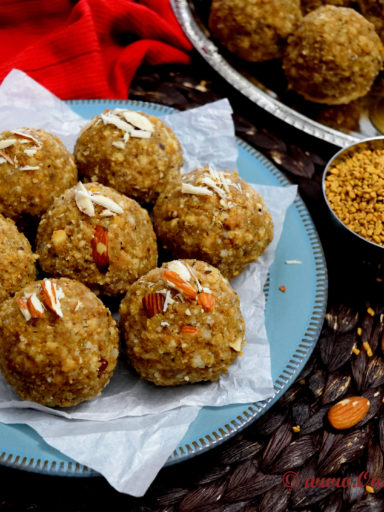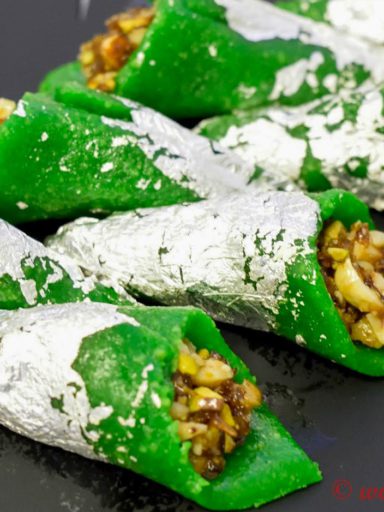Rajasthani Mawa Gujiya/3 Ways Gujiya
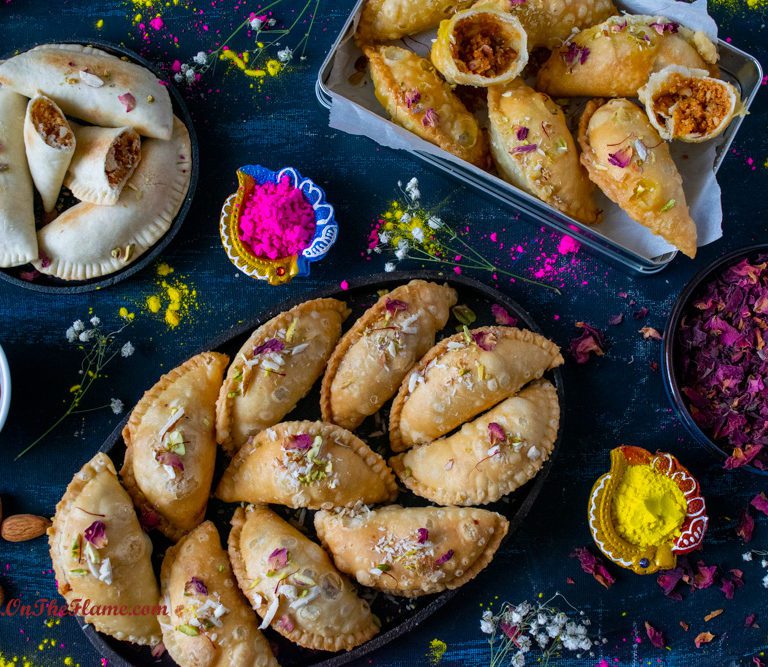
As springs nears, everything starts to cheer up and gets colorful. And with this happy vibe we Indian celebrate our most colorful festival — Holi! Holi also known as festival of colors, is celebrated all across India with great enthusiasm and happiness. One of the best part of any Indian festival is mouthwatering sweets and savory snacks prepared in every Indian household, made-shared-enjoyed.
Being a Rajasthani, my Holi is incomplete without making and sharing homemade Mawa Gujiya. Gujiya is a crescent shaped deep fried pastry made with maida/all purpose flour and filled with sweet mawa/milk solids and chopped dry fruits. To make Rajasthani Mawa Gujiya, mawa is the main ingredient for stuffing. Fresh homemade mawa makes best gujiya but if you are short of time, you can use store bought too. Click here for Homemade Mawa recipe.

These Gujiyas are very popular in North India, especially during Holi. These Gujiyas are prepared all across the the country with a little variation in recipe and even goes by different names. But out of all Gujiya and Karanji are two names used interchangeably, and are not same. Mawa Gujiya is from Rajasthan, stuffed with mawa as main ingredient, whereas Karanji is form Maharashtra and contains no mawa. Other popular names are Ghughra in Gujarat, Nevri in Goa etc.
Traditionally gujiyas are deep fried in ghee, but you can use neutral flavored oil too. And in this one post along with traditional recipe, I am sharing baked recipe too. Gujiya are also made with or without sugar coating/chasani/sugar glaze, sharing that option too. Isn’t this a lot of learning from one single post.
This recipe post is full-proof tried and tested. I would highly recommend to go through notes before you start making recipes. I have shared all possible tricks and tips to make perfect Gujiya. To shape Gujiya special mould is used, but do not worry you can shape them using yours hands too.
Give these super delicious and addictive Gujiya recipe a try, trust me, this no fail recipe. Make fried or baked, with or without chasani, it all worth the effort!!! Click her for more Indian Desserts & Sweets and Festive recipes.


Step by Step Instructions with Photos
Make the Dough
- Take all purpose flour and salt in a wide bowl. Pour melted ghee over flour and mix by it rubbing between your fingers. This process is called Moyan. Do not skip this process.
- Rub it for 4-5 minutes to form a bread crumb like texture. The dough should come together and hold it’s shape while pressing between fist.




- Now adding water in parts, knead to form a stiff & tight dough. At this point dough might have some cracks, which is fine.
- Cover the dough ball with damp cloth and keep it aside to rest it for at least 10 minutes.
- After 10 minutes place the dough ball on working station and knead it for 5-7 minutes forming a smooth yet tight dough.
- Cover the dough ball again with damp cloth and keep it aside to rest it for at least 30 minutes.






Prepare the Stuffing
Roast Mawa
- In a pan add grated mawa and roast it for 5-6 minutes on medium-low flame or until light golden brown, while staring continuously. Mawa should leave the sides and gather around itself.
- Switch off the flames and transfer to a bowl. Keep aside and let it cool down completely at room temperature.
Note: Keep stirring it continuously or else it will burn or stick to bottom of the pan.






Roast Nuts
- Roughly chop nuts and raisin and keep aside. You can use food processor too to make coarse mixture. Do not grind it too fine powder.


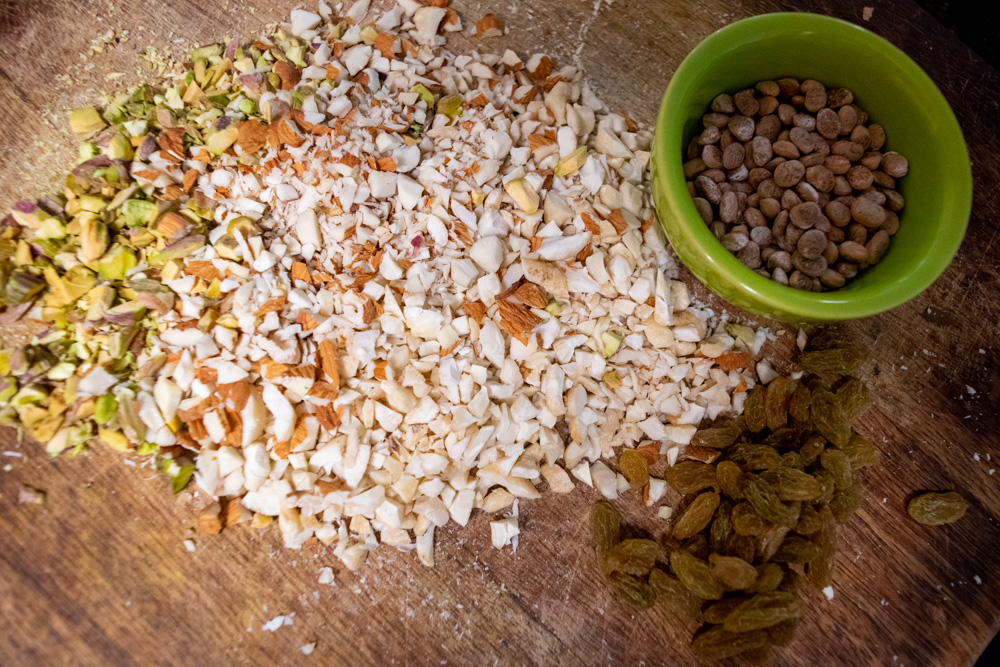

- In a same pan add 1 Tbsp of ghee and add chopped nuts and raisin. Fry everything on low flame for 2-4 minutes or until nuts turn light golden and fragrant.
- Switch off the flames and transfer to a bowl. Keep aside and let them cool down completely at room temperature.




Roast Rawa
- Now add remaining 1 Tbsp of ghee in same pan. Add raw and roast it for 7-8 minutes or until raw turns golden and fragrant.




- Next add in coconut and give it a nice mix. Switch off the flames. Keep aside and let rawa mixture cool down completely at room temperature.




Mix the Stuffing


- Once everything is cooled down at room temperature, will mix everything all together.
- Transfer the mawa in wide bowl. Working with fingers or fork crumble the roasted mawa.
- Now add roasted nuts, roasted rawa mix, cardamom powder, sugar/jaggery powder and kesar strands.






- Working with hands mix everything well. Adjust the sweetness as per your preference. The mixture should be little moist and crumbly.
- Stuffing ready.




Make Chasani/Sugar Syrup
- Soaking gujiya in sugar syrup/chasani is optional. It makes the gujiya moist and gives a wonderful glaze.
- To make chasani add water and sugar in a pan and give a nice boil to make sticky chasani.
- Once sugar is melted completely add in soaked saffron and cardamom/elaichi powder.
- Check the consistency. You don’t need 1 string chasani, sticky chasani works best.
- To check the consistency, take some syrup, cool a little and rub it between your fingertips. If its feel sticky, its perfect. Add rose water and mix.
- Chasani is ready. Keep aside.




Shape & Seal the Gujiyas
- Before you start shaping Gujiya, keep enough ghee/oil on low-medium flame to heat.
- Knead the dough one more time. Make two or three logs and slice the logs into equal lemon size pieces. Rolling between palms, form the balls. Cover with damp kitchen towel as dough balls drys out quickly.
- Now working with one dough ball at a time to a 4-5 inch small circle. Dust the rolling board lightly with some flour if required. The circle should be bigger than mould.


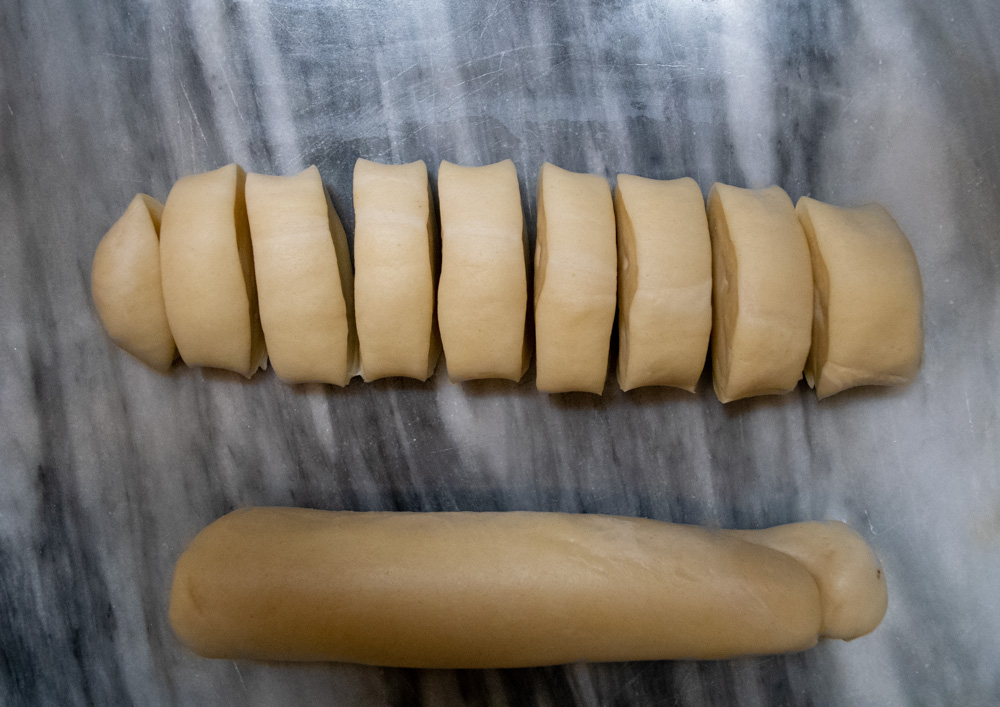

Method 1: Shape using the mould
- This easiest and quickest among all techniques. Sharing pics of the mould for reference.




- place the rolled dough over the Gujiya mould and using your finger apply water all over the edges. Place 1-1.5 Tbsp. of mawa mixture over the dough keeping edges empty. Do not over stuff it or gujiya will break while frying.


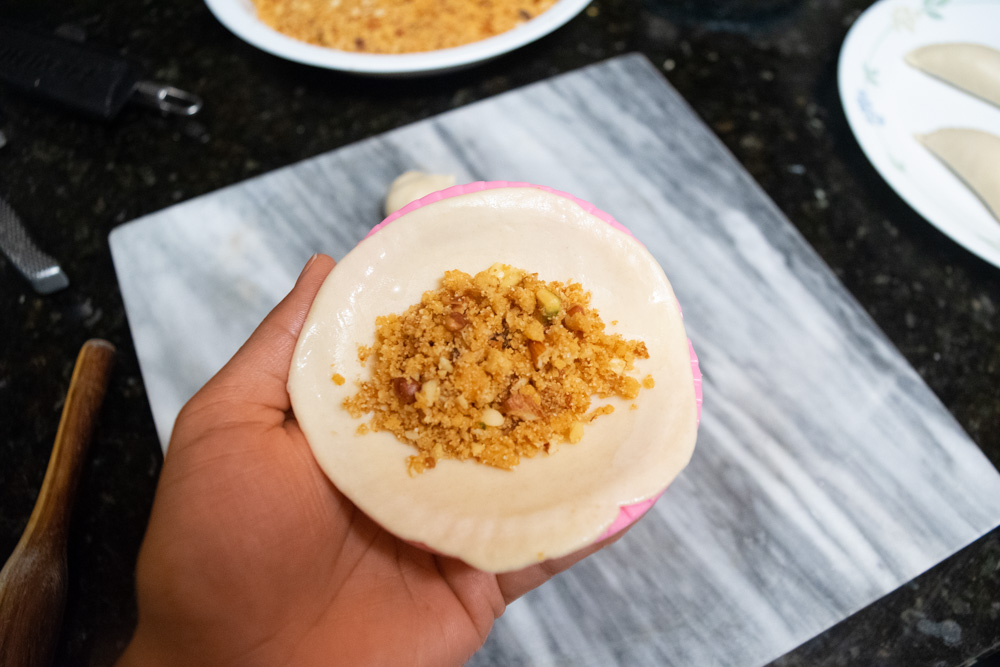

- Fold the mould and gently press to seal it completely. Remove extra dough from the edges. Gujiya is ready for frying. Repeat the process. Cover with damp cloth until frying.




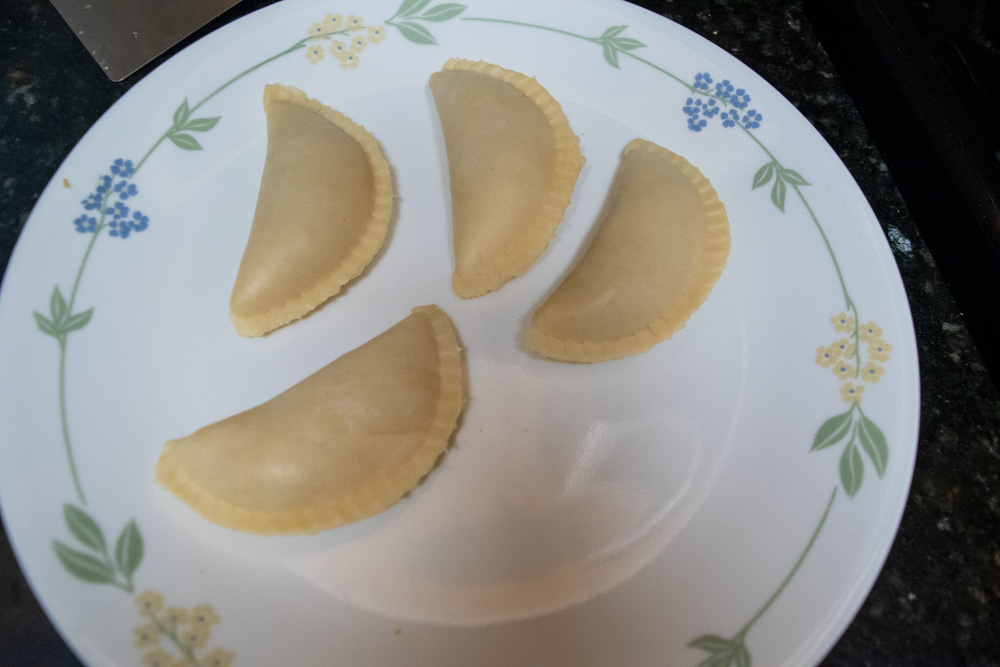

Method 2: Traditional pleating technique
- This technique requires lot of patience and practice. Pleating method is done by hand. But this is one of the efficient method and there a very less chances of breaking gujiyas while frying. And the pleats prevent the filling from coming out.
- To make pleated gujiya place the rolled dough and apply water all over the edges. Add 1-1.5 Tbsp. of mawa mixture to the center, keeping edges clean.




- Now carefully fold the edges to form a semicircle shape. Gently press the edges to seal pinching with your finger tips.
- Now take the folded gujiya and pleated in similar way like your plate samosa. To pleat start from one edge, twist and fold the little dough at a time, finish it off to other end. Please refer to images.
- Gujiya is ready for frying. Repeat the process. Cover with damp cloth until frying.




Method 3: Shape it using fork
- For this technique you will need a cookie cutter/pizza cutter, bowl or sharp knife to trim the edges.
- This step is similar to pleating method until pleating step.
- Once gujiya is sealed, trim the extra edge. Using fork press the edges making design.
- This techniques works best of you are baking, as for frying iy is very important that the gujiyas are sealed properly.
- Gujiya is ready for frying. Repeat the process. Cover with damp cloth until frying.




Fried Gujiya
- Once oil or ghee is hot enough, check the temperature before frying. Add small piece of dough, it should come up gradually. It should not be cold nor too hot. See notes for details.
- Gently slide gujiya in hot ghee/oil and fry them on low -medium heat. Do not over crowd the pan.
- Turn them over carefully after 2-3 minutes. Fry until gujiyas turn golden from both sides. Be patient while frying, turn as needed, do not keep turning them. It will take around 8-10 minutes in total for 1 batch.
- Remove from the gujiyas from pan ghee and place them on a kitchen paper towel.
- Repeat the process for remaking Gujiyas. Gujiyas are ready to serve if you are skipping sugar glaze/chasani. These taste equally delicious.
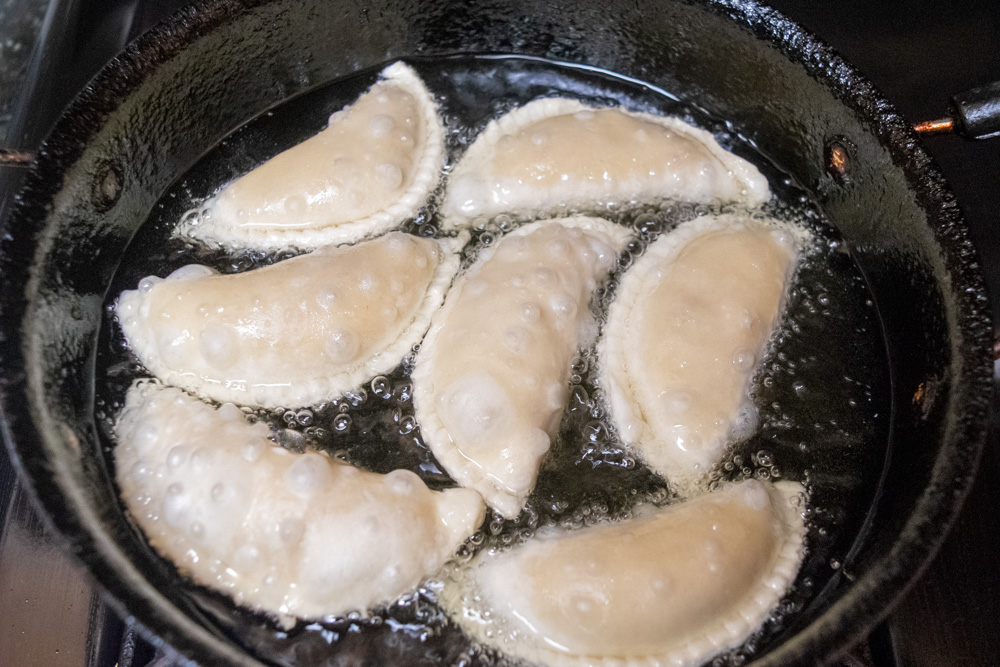





Baked Gujiya
- Preheat the oven to 200 degrees C (380 degree F ) and line the baking tray with parchment paper.
- Place the Gujiyas in single layer on lined baking tray and brush lightly with oil or melted ghee on both the sides. Brush it to coat evenly.
- Now place the Gujiyas tray in preheated oven and bake it for 8-10 minutes. Time might vary with size and type of oven.
- Keep an eye while baking Gujiyas until they turn golden in color. Flip them half way through for even baking.
- Place them on wire rack for cooling. Repeat the process for remaking Gujiyas. Gujiyas are ready to serve if you are skipping sugar glaze/chasani. These taste equally delicious.






Chasani Wali Gujiya/Sugar Glaze
- Once gujiyas are fried and baked, dip the fried gujiyas in the warm sugar syrup for 1-2 minutes to coat well and remove gujiyas to a plate.
- Repeat the process.
- Chasani wali Gujiya are ready to serve. Garnish with dry rose petal, silver leaf or silvered nuts and serve.
- Serve Gujiyas at room temperature or store leftover in an airtight container in fridge.




Recipe Card



Rajasthani Mawa Gujiya/3 Ways Gujiya
Description
Gujiya is a crescent shaped deep fried pastry made with maida/all purpose flour and filled with sweet mawa/milk solids and chopped dry fruits.
Ingredients
For The Dough
For Stuffing
Sugar Syrup
Other Ingredients:
Instructions
Make the Dough
-
Take all purpose flour and salt in a wide bowl. Pour melted ghee over flour and mix by it rubbing between your fingers. This process is called Moyan. Do not skip this process.
-
Rub it for 4-5 minutes to form a bread crumb like texture. The dough should come together and hold it’s shape while pressing between fist.
-
Now adding water in parts, knead to form a stiff & tight dough. At this point dough might have some cracks, which is fine.
-
Cover the dough ball with damp cloth and keep it aside to rest it for at least 10 minutes.
-
After 10 minutes place the dough ball on working station and knead it for 5-7 minutes forming a smooth yet tight dough.
-
Cover the dough ball again with damp cloth and keep it aside to rest it for at least 30 minutes.
Prepare the Stuffing
-- Roast mawa
-
In a pan add grated mawa and roast it for 5-6 minutes on medium-low flame or until light golden brown, while staring continuously. Mawa should leave the sides and gather around itself.
-
Switch off the flames and transfer to a bowl. Keep aside and let it cool down completely at room temperature.
Keep stirring it continuously or else it will burn or stick to bottom of the pan.
--Roast nuts
-
Roughly chop nuts and raisin and keep aside. You can use food processor too to make coarse mixture. Do not grind it too fine powder.
-
In a same pan add 1 Tbsp of ghee and add chopped nuts and raisin. Fry everything on low flame for 2-4 minutes or until nuts turn light golden and fragrant.
-
Switch off the flames and transfer to a bowl. Keep aside and let them cool down completely at room temperature.
--Roast rawa
-
Now add remaining 1 Tbsp of ghee in same pan. Add raw and roast it for 7-8 minutes or until raw turns golden and fragrant.
Keep stirring it continuously or else it will burn. -
Next add in coconut and give it a nice mix. Switch off the flames. Keep aside and let rawa mixture cool down completely at room temperature.
--Mix the stuffing
-
Once everything is cooled down at room temperature, will mix everything all together.
-
Transfer the mawa in wide bowl. Working with fingers or fork crumble the roasted mawa.
-
Now add roasted nuts, roasted rawa mix, cardamom powder, sugar/jaggery powder and kesar strands.
-
Working with hands mix everything well. Adjust the sweetness as per your preference. The mixture should be little moist and crumbly. Stuffing ready.
Make Chasani/Sugar Syrup
-
To make chasani add water and sugar in a pan and give a nice boil to make sticky chasani.
-
Once sugar is melted completely add in soaked saffron and cardamom/elaichi powder.
-
Check the consistency. You don’t need 1 string chasani, sticky chasani works best.
-
To check the consistency, take some syrup, cool a little and rub it between your fingertips. If its feel sticky, its perfect. Add rose water and mix.
-
Chasani is ready. Keep aside.
Soaking gujiya in sugar syrup/chasani is optional. It makes the gujiya moist and gives a wonderful glaze.
Shape & Seal the Gujiyas
-
Before you start shaping Gujiya, keep enough ghee/oil on low-medium flame to heat. Knead the dough one more time. Make two or three logs and slice the logs into equal lemon size pieces. Rolling between palms, from the balls. Cover with damp kitchen towel as dough balls drys out quickly. Now working with one dough ball at a time to a 4-5 inch small circle. Dust the rolling board lightly with some flour if required. The circle should be bigger than mould.
--Method 1: Shape using the mould
-
This easiest and quickest among all techniques. Sharing pics of the mould for reference.
-
place the rolled dough over the Gujiya mould and using your finger apply water all over the edges. Place 1-1.5 Tbsp. of mawa mixture over the dough keeping edges empty. Do not over stuff it or gujiya will break while frying.
-
Fold the mould and gently press to seal it completely. Remove extra dough from the edges. Gujiya is ready for frying. Repeat the process. Cover with damp cloth until frying.
--Method 2: Traditional pleating technique
-
This technique requires lot of patience and practice. Pleating method is done by hand. But this is one of the efficient method and there a very less chances of breaking gujiyas while frying. And the pleats prevent the filling from coming out.
-
To make pleated gujiya place the rolled dough and apply water all over the edges. Add 1-1.5 Tbsp. of mawa mixture to the center, keeping edges clean.
-
Now carefully fold the edges to form a semicircle shape. Gently press the edges to seal pinching with your finger tips.
-
Now take the folded gujiya and pleated in similar way like your plate samosa. To pleat start from one edge, twist and fold the little dough at a time, finish it off to other end. Please refer to images.
-
Gujiya is ready for frying. Repeat the process. Cover with damp cloth until frying.
--Method 3: Shape it using fork
-
For this technique you will need a cookie cutter/pizza cutter, bowl or sharp knife to trim the edges.
-
This step is similar to pleating method until pleating step.
-
Once gujiya is sealed, trim the extra edge. Using fork press the edges making design.
-
This techniques works best of you are baking, as for frying iy is very important that the gujiyas are sealed properly.
-
Gujiya is ready for frying or baking. Repeat the process. Cover with damp cloth until frying.
Gujiya 3 Way
-- Fried Gujiya
-
Once oil or ghee is hot enough, check the temperature before frying. Add small piece of dough, it should come up gradually. It should not be cold nor too hot. See notes for details.
-
Gently slide gujiya in hot ghee/oil and fry them on low -medium heat. Do not over crowd the pan.
-
Turn them over carefully after 2-3 minutes. Fry until gujiyas turn golden from both sides. Be patient while frying, turn as needed, do not keep turning them. It will take around 8-10 minutes in total for 1 batch.
-
Remove from the gujiyas from pan ghee and place them on a kitchen paper towel.
-
Repeat the process for remaking Gujiyas. Gujiyas are ready to serve if you are skipping sugar glaze/chasani. These taste equally delicious.
-- Baked Gujiya
-
Preheat the oven to 200 degrees C (380 degree F ) and line the baking tray with parchment paper.
-
Place the Gujiyas in single layer on lined baking tray and brush lightly with oil or melted ghee on both the sides. Brush it to coat evenly.
-
Now place the Gujiyas tray in preheated oven and bake it for 8-10 minutes. Time might vary with size and type of oven.
-
Keep an eye while baking Gujiyas until they turn golden in color. Flip them half way through for even baking.
-
Place them on wire rack for cooling. Repeat the process for remaking Gujiyas.
-- Chasani Wali Gujiya/Sugar Glaze
-
Once gujiyas are fried and baked, dip the fried gujiyas in the warm sugar syrup for 1-2 minutes to coat well and remove gujiyas to a plate. Repeat the process.
-
Chasani wali Gujiya are ready to serve. Garnish with dry rose petal, silver leaf or silvered nuts and serve.
-
Serve Gujiyas at room temperature or store leftover in an airtight container in fridge.
Note
For the Dough
- Flour: Traditionally all purpose flower is used to make Gujiya but you can opt for whole wheat flour too, to make healthier version.
- Salt: Do not forgot to add pinch of salt to the dough to bring out the flavors.
- Ghee: Moyan is very important to make crispy and flaky Gujiya. Use ghee for best result. To check moyan, press the dough between your fist. The dough should come together and hold it’s shape. If not add more ghee to get perfect moan.
- Gujiya dough: The dough should be tight and firm to make perfect gujiya. Soft dough will make soft outer texture. And let the dough rest for minimum 30 minutes for best result.
- Cover: Always keep your dough, dough balls and even shaped gujiya covered with moist cloth to prevent drying.
For the Stuffing
- Khoya/Mawa: Khoya is main ingredient to make mawa Gujiya. Check here for homemade Mawa recipe. You can use store bough mawa too.
- Nuts: You can used your choice of nuts, adjust the quantity accordingly. Do not skip roasting the nuts, as mentioned in recipe. Roasting nuts release their essential oils and enhance the flavor.
- Rawa/Coconut: Rawa and coconut both are optional. You can skip if you like or adjust the quantity as per your taste preference. But these both ingredients goes really very well with the stuffing.
- Sugar/Jaggery powder: You can add either of these. I have added jaggery and its taste really good. Just remember to use powdered one. And also adjust the quantity as per your taste preferences.
- Cool the filling: Before mixing stuffing, every thing should be cooled down completely and should be at room temperature.
Sugar syrup:
Soaking gujiya in sugar syrup/chasani is optional. It makes the gujiya moist and gives a wonderful glaze. You don’t need 1 string chasani, sticky chasani works best. To check the consistency, take some syrup, cool a little and rub it between your fingertips. If its feel sticky, its perfect.
Filling: Do not over stuff the Gujiya with feeling, too much feeling might tear Gujiya while frying.
Seal & Secure: To avoid a mess while frying, always make sure gujiyas are sealed very well. To seal and secure Gujiya, apply little water around the edges of the dough and seal. Poorly sealed Gujiya might burst and filling may come out while frying.
Ghee/Oil: Gujiyas can be fried in ghee or any neutral flavor oil. For best result use ghee. You can use either of equal parts of both to fry the Gujiya.
Frying in batches: Always fry Gujiyas in batches, do not over crowd the pan. Fry Gujiya in wide-deep pan to allow room for the gujiyas to float around.
Oil temperature: Always fry Gujiyas in medium hot oil. To check the temperature before frying, add small piece of dough, it should come up gradually. If dough comes quick, oil is too hot and if dough sink and take time to come then the oil is not hot enough. It should not be cold nor too hot.
Frying in hot oil, will result in uncooked Gujiyas. Outer layer will brown faster while the inside dough will remain uncooked. Likewise, frying in moderately hot oil will make soggy Gujiya and it will soak up oil. Gujiya might break while frying in low temperature in the oil.
Soaking in Gujiya in Chasani/Sugar Glaze: Chasani or soaking Gujiya in syrup is very personal preference. If you want to cut down on sugar, you can skip this part.
Storing the left over: Serve Gujiyas at room temperature and store left over in air tight container for 1 week. Mawa Gujiya won't stay fresh long at room temperature. Store leftover in refrigerator.




